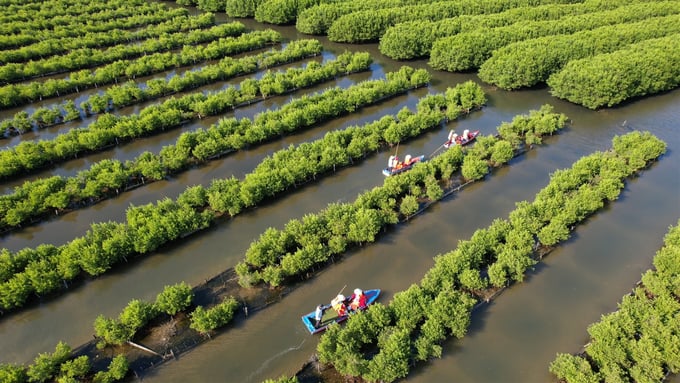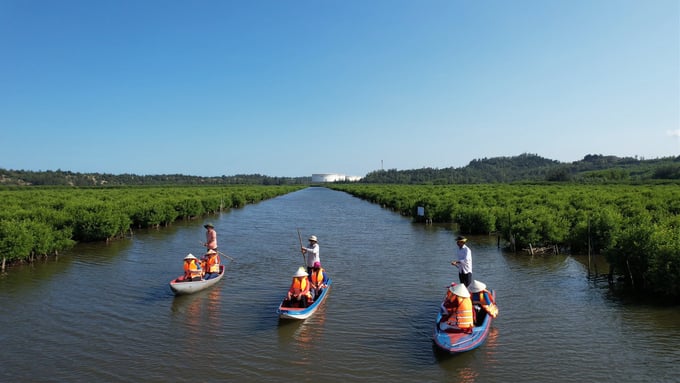November 25, 2025 | 05:56 GMT +7
November 25, 2025 | 05:56 GMT +7
Hotline: 0913.378.918
November 25, 2025 | 05:56 GMT +7
Hotline: 0913.378.918

Bau Ca Cai mangrove forest covers an area of approximately 110 hectares in Binh Thuan commune, Binh Son district, Quang Ngai province. Photo: L.K.
Located in Thuan Phuoc hamlet, Binh Thuan commune, Binh Son district, Quang Ngai province, the Bau Ca Cai mangrove forest covers an area of approximately 110 hectares on a natural lagoon. With its proximity to the sea, Bau Ca Cai has been designated as a protection forest specializing in wave and wind breaking. Over the years, the forest has shielded and protected local villages and residents from major storms.
Bau Ca Cai mangrove forest, with its diverse ecosystem, provides a natural habitat for various aquatic species and a livelihood for the local community. As a resident of Thuan Phuoc hamlet, Binh Thuan commune, whose livelihood has been deeply connected with the mangrove forest for over thirty years, Nguyen Khuong, 67, shared that aquatic species typically follow the water currents to Bau Ca Cai to breed after each flood season. Consequently, the lagoon is populated with shrimp and fish following a flood season.
"As long as local farmers are strong enough, they can earn a few hundred thousand dong daily by setting traps in the forest. The local aquatic species are all considered delicacies, so they have high economic value. Over the years, Bau Ca Cai has nurtured and protected the local residents; thanks to its shrimp and fish populations, families have been able to raise and educate their children. With the current level of local economic development and the establishment of new economic zones, mangrove forests play a significant role in air regulation and environmental improvement," Khuong added.

Beyond its role as a green lung, the Bau Ca Cai mangrove forest has become an attractive community tourism destination for many visitors. Photo: L.K.
However, the progress of climate change in recent years has posed a significant impact on the local mangrove forest area. Namely, the decline of the indigenous Lumnitzera racemosa tree has aggravated coastal erosion and the depletion of coastal aquatic species due to the lack of shelter. In response to this challenges, Quang Ngai province has focused on implementing several restoration and reforestation projects in order to maintain and enhance the role of the Bau Ca Cai mangrove forest.
In the years between 2015 and 2021, the province received approximately 33 billion VND to implement three projects in the communes of Binh Thuan, Binh Tri, Binh Dong, and Binh Phuoc in Binh Son district. Among these projects, the Bau Ca Cai mangrove forest restoration project, coordinated by the Green Climate Fund (GCF) in collaboration with the government and Quang Ngai Provincial People's Committee, has focused on planting several hectares of Rhizophora apiculata Blume, Nypa fruticans and Lumnitzera racemosa. Subsequently, the project has reported positive initial results.
After nearly ten years of concerted efforts from the local government, organizations and residents,the province successfully planted several hectares of new mangrove areas. Complemented by the responsible care and protection of local residents, Bau Ca Cai flourishes to become the green lung for the coastal community. This restoration effort has also revived the natural habitat for aquatic species. Additionally, local residents have invested in farming various species of shrimp and fish, thereby maintaining stable livelihoods and improving income.
Recognizing Bau Ca Cai mangrove forest's potential for ecotourism development, Binh Thuan commune established the Bau Ca Cai Community Tourism Group, with the participation of multiple local households. The group is responsible for creating protection and management mechanisms, setting exploitation limits, and establishing connections with travel agencies in order to design tours and provide instructions to participating households. Additionally, the group has formed task forces to prevent destructive exploitation activities that cause environmental and forest degradation.
Thanks to the local restoration and preservation efforts, Bau Ca Cai mangrove forest has emerged as a captivating destination for both local and international tourists. The development of tourism has revitalized the rural landscape and significantly improved the local community's economy. According to Quang Ngai province's Department of Agriculture and Rural Development, with the aim of further utilizing the advantages of Bau Ca Cai mangrove forest, the province plans to strengthen and integrate various funding sources for the sustainable management, protection, and development of coastal mangrove forests.
Ho Trong Phuong, Director of the Quang Ngai province's Department of Agriculture and Rural Development, stated: "In addition to allocating state budget funds for the management and protection of existing mangrove areas, the province will actively encourage investment and integrate diverse funding sources to promote the sustainable management of mangrove forests, with a focus on conservation efforts and eco-friendly community tourism development. This strategic approach aims to contribute to reinforcing climate change resilience, creating employment opportunities, and providing sustainable livelihoods for local residents."
Translated by Nguyen Hai Long

(VAN) Green transition is crucial for the Mekong Delta amid climate change and stricter standards, offering a path toward sustainability.

(VAN) Dong Thap promotes agricultural restructuring, forms large specialized farming zones, raises the value of agricultural products and develops toward ecological and high-tech directions.
/2025/11/22/4018-4-213342_747.jpg)
(VAN) The Mekong Delta Agricultural Experts Club has attracted 143 experts and researchers to participate in providing consultancy and contributing initiatives to the development of one million hectares of high-quality rice.

(VAN) Ca Mau’s development of OCOP products opens a path to increasing cooperatives value, helping boost income, expand markets, and affirm collective economy's role.

(VAN) Turning seemingly ordinary coconut shells into unique jewelry and artwork, Nguyen Bang Nhi spreads the value of local culture through her brand, Cocohand.

(VAN) Results from the Sustainable Durian Model Project in Dak Lak have confirmed the critical role of Yara Viet Nam in transferring advanced nutritional solutions to farmers.

(VAN) In Tuyen Quang province, livestock farmers have introduced effective models and innovative practices that significantly strengthen African Swine Fever prevention and control efforts.